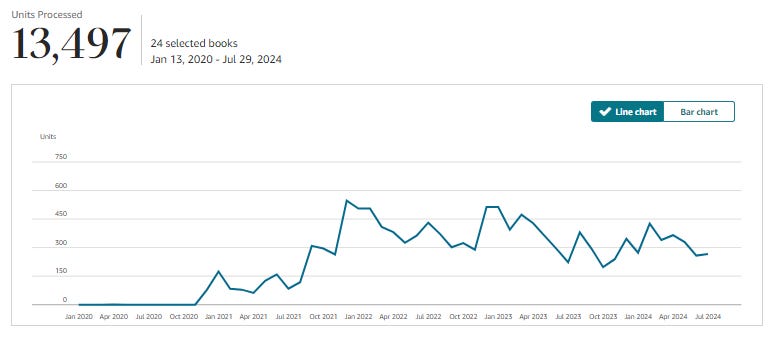My summer writing break is now over. For the last two weeks, I have been camping and driving through Germany, France, and Italy with my family. It has been great with some time off and away from chess, and I feel motivated to return to writing about chess.
I’m unsure if I have announced this yet, but I have registered my own company. Say Chess Publishing.
It has been a gradual process to reach this point because first chess was a hobby for me (and in some way still is). However, things changed when I started publishing books since I started earning royalties from the book sales. Money brings both opportunities and responsibilities.
The pure amateur playing chess as a hobby probably has the easiest time loving the game.
While chess professionals or semi-professionals have committed themselves to earning money connected to the game they love. With the creation of The Chess Gym at the beginning of the year, I felt I pivoted too much of my energy toward administrative tasks which I did not think was sustainable. I’m therefore very mindful about finding the right balance moving forward.
However, with the continued growth of the newsletter and book royalties, I have needed to find out if I wanted to continue the path toward maybe someday being able to become a full-time chess professional (if I want to).
I have read that “A professional writer is an amateur who didn't quit.” And in a sense that is true for me. I have continued creating chess content for several years now.
The income I now earn from chess is no longer minuscule; it supports my family in a meaningful way, though it is not yet sufficient to sustain a high living standard in Denmark on its own.
It has allowed my wife to take care of our youngest child (out of four) at home and hopefully will create new opportunities in the future as well. Chess is no longer only a hobby that I love, but also a business. I find great joy in writing this newsletter and authoring chess books, making the creation of Say Chess Publishing a natural progression.
But how do I create a successful chess business as a lone writer with a full-time job?
Currently, Say Chess Publishing has two income streams:
Book royalties from Amazon
Paid subscribers to this newsletter — thank you for the support!
As you can see below I’m seeing a good growth of new paid subscribers to the newsletter, which I’m grateful for. At the same time, the sales of the books on Amazon have flattened out.
Part of the explanation is that I lately have prioritized earning a royalty when I sell books vs. selling a high volume of books.
Meanwhile, a thesis may be that more people are studying chess with digital resources (YouTube, Chessable, ChessTempo, and so on), which is making competition harder.
A Guardian article from the beginning of the year notes there are also counter-trends to the ever-more digitized world. So, maybe chess books will be booming again?
My point is that it is hard to predict what will happen, so to make a more stable business that can withstand trends I want to add a third leg to my currently two-legged business.
It is here that Chessable enters the picture. For some time I have wanted to publish a course on Chessable, but my previous books have for different reasons not fitted into the Chessable move trainer framework. Yes, The Tactics Ladder would, but I have decided that it is too grand of a project to annotate all 5,000 puzzles and convert them into a course. I also like how the books are as they are now — an alternative to solving puzzles online without distractions and ratings.
Instead, I have been talking with the staff on Chessable to create a special course only for that platform in mind. I like the idea of creating something that fits perfectly into their format instead of altering something to fit into it.
After Chessable now is part of the Chess.com group I only think more people will be studying chess on Chessable in the future. Earlier I was critical about this merger, and I’m still not sure that it is the best thing for the chess world due to the lack of competition, but I also have to come to terms with the reality. If I want to sell chess books I have to put up a stand where the customers are.
It is of course also a major plus that Chessable is a good platform to practice on.
What will the course be about?
For now, I will say that I think I have a good idea. It will be a course about tactics for beginners rated 400 to 1000 on Chess.com. If you are rated in that range and want to chat with me about improving at tactics, please leave a comment below or e-mail me at saychess1@gmail.com
Please also leave a comment if you have any good advice on what makes a great course on Chessable.
/Martin






As a Chessable author, students tend to like lots of explanation of moves and thorough analysis of alternative moves in tactic courses ("Why doesn't reasonable-looking-move xyz work?"). Not sure how important this is for a tactic course targeted for u1000 rated players though. Also, students tend to like when courses are regularly updated or when the author answers questions that are asked in the forum/position comments. With a tactics course I don't think updating the course later on with additional puzzles is necessary but answering questions and making small updates to the text tends to be a good thing to consider and keeps students happy while also looking good for potential future students.
Dalton's courses are a fantastic model for how to maximize the Chessable course structure. His French Simplified is terrific. I am a huge fan. Representing ideas "theory sections" vs a "tactics section" is quite helpful.
I think if you could build a course that works all around a traditional opening, highlighting typical tactics that you can see in that opening you would have something quite popular.
Most of the time, this would be the result of "bad play" in which someone doesn't get what should be happening on the board.
u1000 players don't want to be "that guy" and they want to see how to punish opening mistakes. They know they should be able to but they don't seem to have the imagination to snag much more than hanging pieces. Tactics centering around pins, deflection, simple double attacks--but that are reached out of the same opening would be useful.
Or maybe you could turn things around and offer simple defensive technique out of 1...e5: typical beginner attacks and tactics that someone can anticipate. I wouldn't do anything deeper than 10-12 moves.